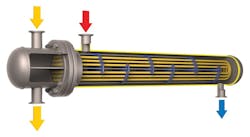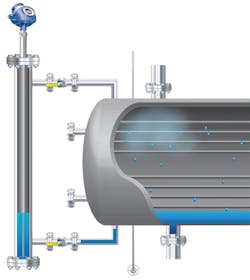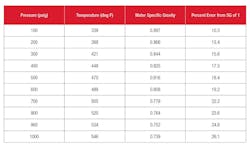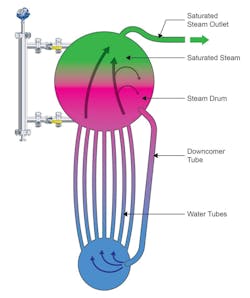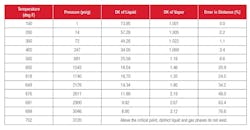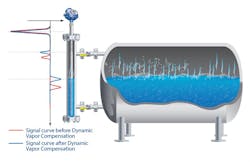Overcoming level gauging challenges in boilers
For large boiler applications, particularly those in which steam is used to drive turbines and produce power, accurate level measurements at critical points in the process are necessary, but they can be particularly challenging. A high degree of accuracy can provide greater operational efficiency and avoid conditions that might cause degradation or failure of equipment such as the turbine.
This article focuses on level measurements for two specific applications: feedwater heaters and boiler drums. The basic methods used in these applications are examined, and case studies illustrate each approach. Depending on a given plant’s configuration, either — or possibly both — application could reside at a single location.
Application 1: Feedwater heaters
When steam comes out of the exhaust vent of a turbine, it goes into a condenser where it is sufficiently cooled to condense back into water (see Figure 1). This creates a negative pressure on the back side of the turbine as well as a larger pressure differential from the inlet, which helps prepare the water to be sent back to the boiler and used again.
Water coming out of the condensers is hot, but if further heated, it can increase boiler efficiency. The colder the feedwater is the harder the boiler has to work to return it to steam at the desired pressure. This effort is quantified as a boiler’s “heat rate,” which is the measure of energy put into a system against electricity produced, typically British thermal units (Btu)/kilowatt hour (kWh). The amount of heat energy (Btu) is divided by the amount of electricity generated (kW) over time. Essentially, the heat rate indicates how much fuel must be burned to generate a specific amount of electricity, and the lower this number is the better.
Obviously, the heat rate has a substantial effect on the efficiency of a plant. For a medium-sized utility operation of 500 megawatts (MW), a 1 percent improvement in heat rate can save $500,000 in fuel. Consequently, feedwater heaters are used to raise the temperature of the condensate just before it is injected back into the boiler. This can drive a major improvement in overall boiler performance.
A typical feedwater heater uses a tube-and-shell design in which it pumps water through the tubes surrounded by steam that is diverted away from the turbine (see Figure 2). While this reduces the amount of steam available for the turbine, the gains realized more than make up for the loss because the overall amount of fuel consumed goes down. Typically, the feedwater temperature increases from 110ºF to 570ºF as it passes through this heat exchanger. This is significant since even a 5ºF increase reduces the heat rate by 0.1 percent, so small improvements add up over time.
Figure 2. Steam introduced into the shell heats condensate flowing through the tubes.
Maintaining correct level
While this concept is very straightforward, complications emerge when trying to control steam flow to the feedwater heater. The steam is in the shell and heats the liquid through the tubes. To get maximum heat transfer and efficiency, the steam should condense fully within the heater, so there should be some water accumulation inside. Any steam blown out represents unrecovered heat, and the water accumulation helps protect against tube leaks, so some condensate within a specific level range is desirable. At the same time, too much condensate accumulating in the heater reduces efficiency. The tubes should be mostly exposed to the steam for maximum heat transfer.
The worst situation arises when the steam section becomes fully flooded with condensate. This not only drastically reduces efficiency, it also can cause condensate to back up all the way to the turbine, blasting water into the blades along with steam. This can damage the blades and reduce turbine life, potentially causing catastrophic failure of the turbine. Effective level control to protect against turbine water induction is so critical that American Society of Mechanical Engineers (ASME) Code PG.60.1.1 calls for feedwater heaters to be outfitted with two direct-level readings via sight glasses or one direct-level reading combined with two indirect readings, plus high-level switches.
Real-world level solution
A three-unit coal-fired facility that burns low-sulfur coal in the western United States wanted to improve its level measurements. Units 1 and 2 of the facility are conventional sub-critical designs from the 1970s. Unit 3, constructed in 2010, is super-critical and has extensive emission controls. All three units have similar feedwater heater trains, each with three heaters connected in series.
Until recently, the feedwater heaters were outfitted with pneumatic systems built around triple-redundant, differential pressure (DP) level measuring systems. While the operators understood that changes in density — related to temperature in the heater — affect density and, therefore, the accuracy of the level reading, the system did not make an adequate correction. So, as the temperature changed due to variable unit loading, so did the level, even though the indicator said it was consistent (see Table 1). It was not uncommon to have a 20 percent error, which caused a loss in efficiency.
Figure 3. GWR level instruments are well-suited to the external level measuring configuration common in boilers.
To solve this problem, the plant installed a Rosemount Model 5300 guided wave radar (GWR) level instrument (see Figure 3) on one of the feedwater heaters in a three-heater train as a test. This technology was selected for several critical operational characteristics:
- Level measurement independent of density changes
- Able to withstand the high temperatures and pressures characteristic of the application
- No moving parts
- No need for ongoing calibrations or zeroing
- Largely unaffected by changes within the vapor space
GWR instruments can be equipped with a reference reflector able to determine when changes within the application are severe enough to affect reading accuracy. The reflector is a step change in the probe diameter. A portion of the microwave pulse sent down the probe is reflected by this step, and the transmitter is able to detect this partial echo in addition to the echo from the liquid surface.
Table 1. The degree of error characteristic of DP level instruments and float level sensors increases as pressure and temperature levels increase.
Since its distance is fixed, the reference measurement will always be the same when ambient. When vessel conditions within the unit change (increase or decrease in temperature), an offset in the reflector pulse will occur. The transmitter characterizes the difference and uses it to calculate the steam dielectric in real time, which is applied as a corrected offset to the liquid level reading. So, for example, if the indicated distance to the reference reflector changes by 5 percent, the instrument will apply compensation to the liquid level reading based on this disparity. That way, the radar is always accurate throughout startup, shutdown and load changes.
The plant combined this technology with new Global Performance Advisor (GPA) software connected to the larger distributed control system (DCS) for the plant. This GPA software helped the plant create control room graphics capable of monitoring performance of the feedwater heater much more closely. It added the ability to calculate heater terminal temperature differences and drain cooler approach temperatures so they could be compared to the design values to optimize throughput. Once implemented, the actual efficiency realized matched design capabilities closely, even through multiple plant loading changes.
Once the new approach had operated for some time, the plant recognized a 2ºF increase across the single heater in the train. The plant upgraded the other two heaters in the same way to gain a 6ºF improvement across the train. For this plant, a 6ºF increase reduced the heat rate by 13.4 Btu/kWh, or about 0.12 percent. This might not sound like much, but for a 500-MW unit, it translated into cost savings in excess of $70,000 per year, resulting in a pay-back time of eight months. Extrapolating the solution to the whole plant would result in approximately $200,000 in savings each year.
In addition to the energy savings, the plant also realized a reduction in wear on equipment as well as environmental improvements. The facility is an extremely clean-burning coal plant with low-nitrogen-oxide (NOx) burners, selective-catalytic-reduction systems, sulfur-dioxide-reducing lime dryers and baghouses to remove particulate emissions from the flue gas. Reducing overall fuel consumption reduces output of all pollutants, so less ammonia is necessary to neutralize NOx, less carbon must be injected to control mercury emissions, and particulate emissions in general are reduced. These are more difficult to quantify directly, but are clearly improvements on all fronts.
Figure 4. Keeping enough water circulating while maintaining dry steam requires precise level control in a chaotic environment.
Application 2: Maintaining boiler drum stability
While the population of operating conventional coal-fired power plants is declining, combined-cycle gas turbine (CCGT) facilities are growing in number due to low gas prices and environmental aspects of older technologies becoming more problematic. But whether fired by coal or capturing heat from gas turbine exhaust, most boiler designs use a drum to circulate the boiling water and collect steam (see Figure 4).
Controlling level in an industrial heater drum is critical, and control begins with accurate level measurement. Most boilers will trip if the level gets too high to avoid sending water into the steam line. They also trip if the level gets too low because this could cause the boiler to run dry. Depending on the size of the boiler, a level deviation of as little as 2 or 3 inches can cause a trip.
Maintaining this critical level is easier said than done because a boiler drum is a very turbulent and chaotic place with high temperature and pressure. The separation between liquid and gas becomes harder to define due to the vapor and changing liquid density. Many of the traditional methods used to measure level do not work well.
Generally, the preferred level-controlling method is DP, but changes in density can add a high degree of error – up to 30 percent (see Table 2). For example, if the turbine is run hard, and more steam is pulled from the boiler, more bubbles will erupt in the liquid, reducing density. Based on a DP reading, the drum will appear to be experiencing a drop in level when actually level has not changed at all. Often plants have a compensation mechanism for temperature or pressure in the DCS; however, it usually does not represent what is truly happening in the drum, nor do these mechanisms compensate for errors in specific gravity occurring in the tubing from ambient temperature changes.
Most plants try to avoid drifting readings by using multiple DP instruments in voting schemes, but this does not correct the basic problem. Moreover, most of these instruments are installed using impulse lines, which can clog or freeze, obstructing the reading and leaving operators blind.
One choice some users have experimented with, which has been proven capable of avoiding the density problems of DP measurements, is GWR. Deploying GWR instruments helped users overcome the density variations, and these instruments were able to tolerate the temperatures and pressures involved, though some units were thrown off by the variability of the dielectric constant (DK) caused by saturated steam within the drum.
Early experiments showed GWR could also be fooled, producing readings with a 20 percent error because a change in the DK of the steam caused it to miscalculate the distance to the liquid surface (see Figure 5). Some units allowed users to add a compensation factor manually, which helped. However, when operating conditions changed, so did the DK.
The same self-compensation capability mentioned earlier also solves a similar problem in this application. When a GWR instrument is able to measure the distance to its reference reflector, it can calculate its own compensation factor dynamically, even when the DK of the steam is constantly changing. This dynamic vapor compensation can reduce level measurement errors to less than 2 percent, even in dynamic conditions, while eliminating the maintenance problems related to impulse lines.
Table 2. Specific gravity and dielectric constant values change with temperature and pressure, and both are capable of disrupting level measurements.
Balancing boiler drum level
A 900-MW CCGT plant in the southeastern U.S. was struggling with a level-controlling problem. It was using DP level instruments in a two-out-of-three (2oo3) voting scheme to keep its three boilers on an even keel. Under normal conditions it operates at 2,300 psi and 650ºF at the drums. During peak demand, production value is more than $1,000 per MW, so any unplanned shutdown costs hundreds of thousands of dollars per hour.
Since the area was prone to occasional freezes during the winter, the DP instruments were protected in an enclosure with the impulse lines heat traced. Even with these precautions, the heat tracing was not fully effective, and the plant experienced multiple trips each winter. Getting the plant stabilized after a trip normally involved operator overtime to get things thawed and back in operation. These losses provided additional motivation to find an alternative.
The plant changed all three boilers to instruments equipped with dynamic vapor compensation capabilities. The instruments were mounted in external bypass chambers, and the plant’s control system retained the 2oo3 voting scheme. The new configuration met all the ASME B31.1/BPV1 code requirements. After the installation, the plant survived the winter with no outages, or even near misses, related to boiler drum level measurement, allowing the instruments to pay for themselves after just one winter, according to the site engineering manager.
Figure 5. Dynamic vapor compensation is necessary to avoid measurement errors caused by changes in radar pulse speed in the vapor space of the drum.
A solution for many applications
As shown in these two examples, GWR level instruments are very practical for boilers, deaerators, feedwater heaters, LP/IP/HP heaters and other steam drums. They are particularly well suited to mounting in bridles, similar in orientation to existing sight glass installations. They are immune to changes in liquid density and temperature. Even in situations in which the DK of vapors is variable, the ability of GWR instruments to self compensate extends accuracy and reliability.
In more general level measuring applications, having a probe to guide the microwave signal helps overcome some problems associated with non-contact radar and ultrasonic technologies such as ghost readings from mixer blades, heavy vapors, condensation, ladders and other internal obstructions. The ability for the signal to follow the guide provides a positive reading even in a variety of difficult applications.
GWR level instruments are an excellent choice for many difficult applications, particularly those in which it is important to have precise level measurement in a challenging environment.
Matt Brummer studied electrical engineering at North Dakota State University and proceeded to work in assuring customer solutions in automation. He is the field level specialist leader for North America at Emerson Automation Solutions.


